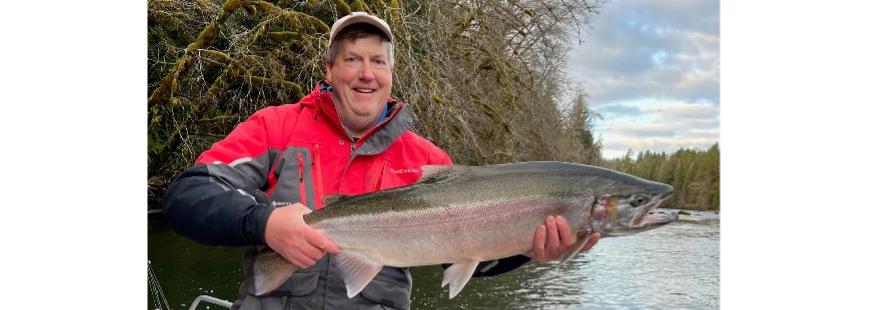The news just keeps getting better for West Coast groundfish. Ringing in the New Year comes with good news for saltwater anglers in Oregon, and other West Coast ports as well.
For starters, the seasonal depth restriction has been lifted, which should excite many anglers. It’s like the good ol’ days all over again, with proper management this time. Hopefully that equates to sustained opportunity for decades to come, but there are many X-factors in the future of our fish stocks. No one would question that. You can view what lies ahead for ocean fisheries off the Oregon Coast HERE.
Lingcod is the true success story on the West Coast. When I first started targeting bottomfish (because salmon were in the dumps), lingcod were rare and bag limits very restrictive. Now, not only is the 2-fish bag limit achievable year-round, but we now also have year-round access to them on the deep reefs, where fishing pressure has been relatively light in the last 2 decades. Fish are bigger and more numerous, and populations are more productive, because of it. A true West Coast success story.
Humans have compromised many fish populations over the centuries, but with experience comes knowledge, which hopefully leads to proper management. Most groundfish populations have thrived under a more conservative approach to management, founded under the guidelines of the Magnuson-Stevens Act. It’s still due for an update in Congress; seems our elected officials haven’t made it a priority, as a collective anyway.
Are we waiting for another disaster so we can rush in for legislation to fix it? Let’s hope not. With the changing climate and the threat of ocean acidification, now is as good a time as any to be forward looking in what we want to achieve for long-term sustainability for our ocean fisheries. It’s all too easy to place visionary legislation on the back burner when things are going our way. Building a better working waterfront should be the priority for all coastal communities and those that represent them in Congress.
One thing our federal legislators did get wrong before the session ended was not funding the Recovering America’s Wildlife Act. It was teed up to be added into the omnibus package, but failed negotiations between the parties kept it out. It’s a shame since the legislation itself had strong bi-partisan support. If it had passed, tens of millions of dollars would have flowed to Oregon, as well as every other state in the union, to aid fish and wildlife agencies to better fund recovery of sensitive species. Oregon’s list of strategy species includes 60 fish species, many residing in our saltwater environment. With the current budget of around $1 million/year, we could have certainly used a spare $26 million/year infusion to help make meaningful change. Our members of Congress should hear from us about this.
It’s a new year, and conservationists and environmentalists will once again be working to do good for our fish and wildlife species. Anglers will fish, hunters will hunt and wildlife viewers will keep watching. Let’s make it a point to get our kids out there to foster the next generation of caregivers for these greatest natural resources.
I’m not sure I did my best with my 14-year-old daughter this winter break, however.
When not busting down the highway, or digging in on TikTok, my wife, daughter and I put in some time at Yosemite, the Grand Canyon and Joshua Tree on our road trip to escape the approaching ice storm around Christmas in the NW corner of Oregon. We barely escaped the freezing rain, and it wasn’t long before we were in 70° weather in southern California. As much as I enjoy all the precipitation we get in Oregon, I can say I enjoyed the warmer climate, even if it was for just a few days.
What was most striking, however, was the number of people also visiting these iconic national parks over the holidays. It sure made me think, how in the heck does God’s green earth feed all of these consumers? The trek through these national parks was still worth the price of admission, and people seemed to adhere to the guidelines each of these parks put forth. Still, are we loving these places to death? What the heck happens if these people find out about my favorite fishing locations?
And speaking of favorite fishing locations, before heading south, I headed north, to the Olympic Peninsula. This too should be marked as one of the great wonders of the world. I got a rare opportunity to fish the lower Quinault River with a guide in a very unique fishery, one that only Walt Disney could dream up.
A pristine watershed, huge steelhead and no one else fishing on them was a ridiculous situation. It’s rare to catch a steelhead under 14-pounds on this river. It truly gave me a sense of what a watershed’s capabilities are, when its function is largely intact. Just how many rivers can one experience Chinook, coho, sockeye, steelhead, cutthroat trout and Dolly Varden all in the same day?
Thankfully I got to experience such an opportunity, and more thankfully, we have so much public lands and waters on the West Coast. They are worth protecting.
Let’s make 2023 a good one for our fish and wildlife.



Things are always changing when it comes to conservation and future management of our fisheries. I have bee a professional guide fro 23 years on the Galveston bays in Texas and I have seen many rules and regulations among different types of conservation efforts over my 23 years. I might not agree with every single one, but most of the time change is for the betterment of our species and fisheries. I try not to get too political and get my personal feelings hurt when it comes to these things. In the long run usually change is needed and If asked I will give my opinion.